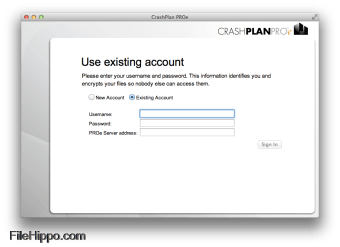CrashPlan can then synchronize with the destination and continue backing up files that now reside in a new location and have a different file path. Step 1: Download and install CrashPlan Download and install the latest version of the CrashPlan app available at https://rcservices.partners.org. To use CrashPlan Mobile, first install CrashPlan on your laptop or desktop. License: CrashPlan has four tiers of service:. Free: Automatic backup to local hard drives and other trusted computers. As low as $0.00 per month. Individual:Add unlimited cloud storage, continuous backup and mobile file access. As low as $3.96 per month. Which version of the file you want to restore. Be default, CrashPlan will restore the most recent version of a file. If you want to download a previous version, click where it says 'most recent' and select the date and time for the version you want. File Permissions (Mac and Linux only). By default, CrashPlan will restore with original permissions. 3) Install CrashPlan on your main client. Naturally, for me this is a Mac. Go to the download page and install the right client for your machine. What you have to remember here is that you are going to point the CrashPlan software to your Synology, not to your local machine. That involves some Terminal work.

Here are instructions on how to restore one or more files from your CrashPlan online backup archive. The instructions work for both CrashPlan and CrashPlan Pro. Dvd ripping free software. In my opinion, an untested backup system is next to useless. Only by testing it do you know for sure that your backup system is working properly. By testing it, you also learn how to restore a file, which will enable you to be a bit more calm in the event of an actual disaster.

If you’re a visual learner, you might like to watch my video demonstration of how to perform a restore from CrashPlan. Download cider mac.
- Open the CrashPlan (or CrashPlan Pro) application by clicking on its icon on your Dock or in your Applications folder.
- On the left-hand side you’ll see six sections. Click on Restore.
- You’ll see the CrashPlan Central Destination listed at the top, as well as the time of the most recent backup. If you want to restore from a backup other than the most recent backup, click the words “most recent” which appear at the bottom of the window. From the calendar that appears, select a previous date and time then click “Ok.”
- Next, select the files or folders you want to restore by inserting a checkmark in the checkbox to the left of the file’s name. You can either use the search field to locate your file or you can click the arrows to the left of folder names to see the contents of the folder. Using these arrows, you can navigate down several layers of folders to locate the files or folders that you want to see.
- The files will be restored to the Desktop by default. If you prefer, you can click on the word “Desktop” near the bottom of the window to select another location.
- Finally, click the “Restore” button.
- “Restore Status” information will be listed at the bottom of the CrashPlan window. Depending upon how many Kilobytes of data you select, it can take a while for CrashPlan to retrieve the files and send them to your computer. When the restoration is complete the status message will list the time at which that the files were restored to the destination on your Mac.
Crashplan Pro Download Mac Download
It’s also possible to restore files from CrashPlan’s web site. This option could be useful if your laptop was stolen or if you’re traveling without your laptop, but need a file. Restoring files from the CrashPlan web site limits you to a maximum of 500 MB.
